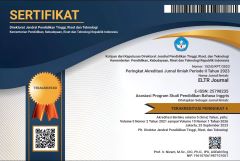THE EFFECT OF DUOLINGO APPLICATION ON STUDENTS’ ENGLISH VOCABULARY MASTERY
Abstrak terlihat: 10407 / PDF terunduh: 8591DOI:
https://doi.org/10.37147/eltr.v4i2.71Keywords:
Mobile-Assisted Language Learning, Gamification, Duolingo, vocabularyAbstract
This paper examined the effect of Duolingo application on students English vocabulary mastery using quasi-experimental with post-test only design. The participant of this research was the eighth-grade students in one of junior high school in Jember. In this study, the experimental group got treatment by using Duolingo application; meanwhile, the control group taught as usual by using flashcard as the media. The data was collected from vocabulary test and was analyzed by using SPSS with independent sample t-test. The result showed a significant difference between students who use Duolingo application and who didnt with the value of significance (0.017) which was less than 0.05 and the mean score of the experimental group (84.69) was higher than the mean score of the control group (80.78). This demonstrates that using Duolingo Application has a significant effect on students’ vocabulary mastery.
Downloads
References
Brigham, T. J. (2015). An Introduction to Gamification Adding Game Elements for Engagement. Medical Reference Services Quarterly, 34(4), 471–480. DOI:10.108002763869.2015.1082385
Burston J. (2014). MALL: The Pedagogical Challenges. Computer Assisted Language Learning, 27:4, 344-357, DOI:10.1080/09588221.2014.914539
Chen, C.-M., Chen, L.-C., & Yang, S.-M. (2018). An English Vocabulary Learning App with Self-Regulated Learning Mechanism to Improve Learning Performance and Motivation. Computer Assisted Language Learning, DOI: 10.1080/09588221.2018.1485708
Chen, X. (2016). Evaluating Language-learning Mobile Applications for Second-language Learners. Journal of Educational Technology Development and Exchange (JETDE). DOI: 10.18785/jetde.0902.03
Connolly, T. M., Boyle, E. A., MacArthur, E., Hainey, T., & Boyle, J. M. (2012). A Systematic Literature Review of Empirical Evidence on Computer Games and Serious Games. Computers & Education, 59(2), 661–686. DOI:10.1016/j.compedu.2012.03.004
Creswell, J. W. (2012). Educational Research: Planning, Conducting and Evaluating Quantitative and Qualitative Research (4th ed.). Boston, MA: Pearson.
Duman, G., Orhon, G., & Gedik, N. (2015). Research Trends in Mobile Assisted Language Learning from 2000 to 2012. ReCALL, 27(02), 197–216
Duolingo Team. (2019). Duolingo AI Research. Retrieved from https://ai.duolingo.com/ on 8th February 2019.
Giannetto, D., Chao, J., & Fontana, A. (2013). Gamification in a Social Learning Environment. Issues in Informing Science & Information Technology, 10, 195-207.
Guaqueta, C. A., & Castro-Garces, A. Y. (2018). The Use of Language Learning Applications as a Didactic Tool for EFL Vocabulary Building. English Language Teaching, 11(2), 61. DOI:10.5539/elt.v11n2p61
Hatch E. & Brown C. (1995). Vocabulary, Semantic and Language Education. Cambridge: Cambridge University Press.
Huang, Y.-M., & Huang, Y.-M. (2015). A Scaffolding Strategy to Develop Handheld Sensor-Based Vocabulary Games for Improving Students’ Learning Motivation and Performance. Educational Technology Research and Development, 63(5), 691–708. DOI:10.1007/s11423-015-9382-9
Kapp, K. M. (2012). The Gamification of Learning and Instruction Game-Based Methods and Strategies for Training and Education. San Francisco: Pfeiffer.
Karjo, C. H. & Andreani, W. (2018) Learning Foreign Languages with Duolingo and Memrise. ICDEL '18 Proceedings of the 2018 International Conference on Distance Education and Learning. p. 109-112. DOI:10.11453231848.3231871
Ketyi, A. (2016). From Mobile Language Learning to Gamification: an Overlook of Research Results with Business Management Students over a Five-Year Period. Porta Linguarum, pp. 45-60.
Kukulska-Hulme, A. (2013). Re-Skilling Language Learners for a Mobile World. The International Research Foundation for English Language Education. Retrieved from: http://www.tirfonline.org/english-in-the-workforce/mobile-assisted-language-learning.
Munday, P. (2016). The Case for Using DUOLINGO as Part of the Language Classroom Experience. RIED. Revista Iberoamericana de Educación a Distancia, vol. 19, pp. 83-101
Nation, I.S.P. (2001). Learning Vocabulary in Another Language. Cambridge: Cambridge University Press.
Palalas, A. (2011). Mobile-Assisted Language Learning: Designing for Your Students. In S. Thouësny & L. Bradley (Eds.), Second Language Teaching and Learning with Technology: Views of Emergent Researchers (pp. 71-94). Dublin: Research-publishing.net.
Rachels, J. R., & Rockinson-Szapkiw, A. J. (2017). The Effects of a Mobile Gamification App on Elementary Students’ Spanish Achievement and Self-Efficacy. Computer Assisted Language Learning. 31(1-2), 72–89. DOI:10.1080/09588221.2017.1382536
Shadiev, R., Hwang, W.-Y., & Huang, Y.-M. (2017). Review of Research on Mobile Language Learning in Authentic Environments. Computer Assisted Language Learning, 30(3-4), 284–303. DOI: 10.1080/09588221.2017.1308383
Stringer, L. (2016). Getting started with Duolingo for Schools. Retrieved from https://www.linkedin.com/pulse/getting-started-duolingo-schools-louise-stringer on 9th February 2019.
Thornbury, S. (2002) How to Teach Vocabulary. Essex: Pearson Education Limited.
Downloads
Published
How to Cite
Issue
Section
License
Copyright (c) 2020 Husnur Rosyidah Aulia, Eka Wahjuningsih, Rika Andayani

This work is licensed under a Creative Commons Attribution-ShareAlike 4.0 International License.













